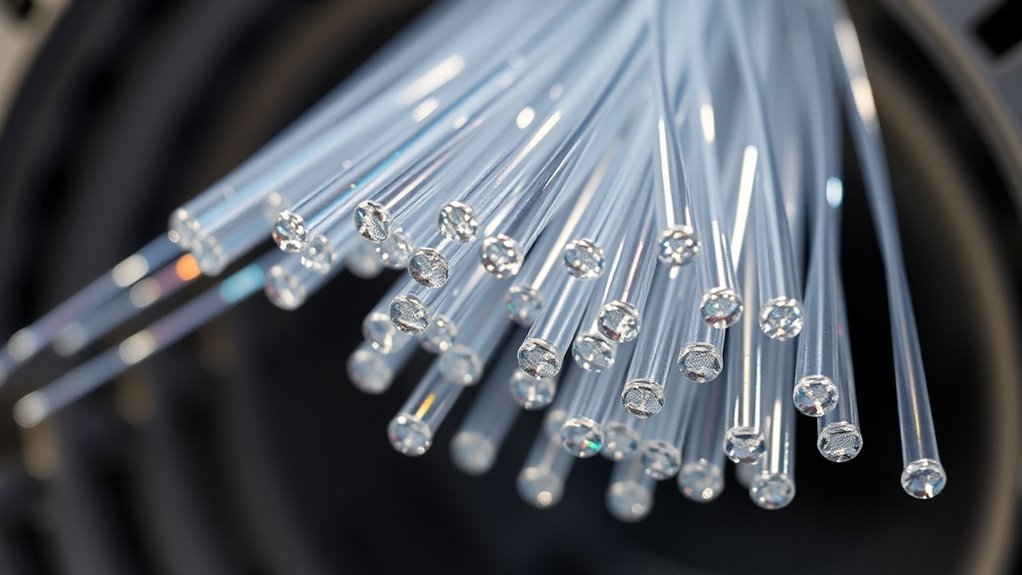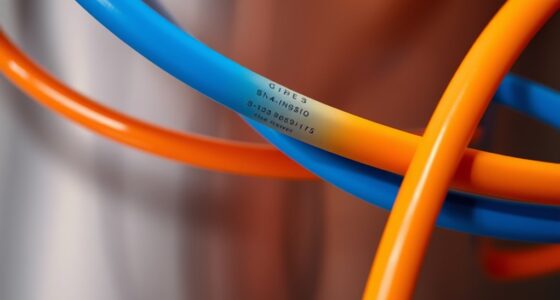Some believe fiber isn’t necessary for 5G backhaul, but evidence suggests it’s essential for supporting the network’s full potential. As data demands grow and applications become more demanding, relying on traditional solutions might fall short. If fiber truly offers the speed and reliability required, then understanding how it integrates into 5G infrastructure becomes fundamental. Exploring this connection can reveal whether fiber truly is the backbone of future digital connectivity.
Key Takeaways
- Fiber provides high-speed, reliable backhaul essential for supporting increased 5G data traffic and network expansion.
- Its immunity to electromagnetic interference ensures stable, secure connectivity for 5G networks.
- Fiber’s scalability allows for easy capacity upgrades, future-proofing 5G infrastructure as demands grow.
- Quick deployment of fiber minimizes downtime and accelerates 5G coverage rollout in urban and rural areas.
- As the backbone of 5G backhaul, fiber ensures high capacity, low latency, and seamless support for dense network infrastructure.

As 5G networks continue to expand, the demand for reliable, high-capacity backhaul infrastructure has never been greater. To keep pace with the rapid growth of data traffic, you need a robust solution that can handle the increased load without sacrificing speed or reliability. Fiber optics stand out as the ideal choice for this purpose, offering the bandwidth and low latency essential for 5G connectivity. When it comes to network deployment, fiber optics provide a future-proof foundation that can support not only current demands but also future technological advancements. By deploying fiber, you’re guaranteeing your network can accommodate the surge in data, streaming, IoT devices, and smart city applications that 5G enables.
Fiber optics ensure reliable, high-capacity backhaul for expanding 5G networks, supporting future growth and technological advancements.
You must understand that fiber optic cables transmit data as pulses of light through thin strands of glass or plastic, which allows for incredible speeds and minimal signal loss over long distances. Unlike traditional copper cables, fiber optics are immune to electromagnetic interference, making your network more stable and secure. This reliability becomes critical in urban environments, where network congestion and interference can hinder performance. When deploying fiber within your network, you get the flexibility to scale up capacity as needed, without the extensive re-cabling or infrastructure overhaul that older technologies demand. This makes fiber optics not just a current solution but a long-term investment.
Additionally, the rapid advancements in fiber optic technology continue to expand its capabilities, ensuring your infrastructure remains competitive and adaptable for years to come. In the context of network deployment, fiber optics simplify the process of expanding 5G coverage. You can install fiber links to cell towers, central offices, and data centers with ease, ensuring high-speed connectivity across wide areas. This quick deployment capability reduces downtime and accelerates service rollout. Furthermore, fiber’s ability to carry large amounts of data at high speeds means your backhaul can support multiple 5G small cells and macro cells simultaneously, preventing bottlenecks. As 5G networks require dense infrastructure, fiber optics give you the capacity to meet these demands efficiently.
Selecting fiber for your network deployment also means you’re preparing for the future. The technology is continually evolving, offering higher capacities and better performance over time. Investing in fiber optics now guarantees you won’t need frequent upgrades, saving costs and minimizing disruptions long-term. Overall, fiber is the backbone of effective 5G backhaul networks, giving you the speed, capacity, and scalability needed to stay ahead in today’s fast-paced digital landscape.
Frequently Asked Questions
How Does Fiber Compare to Microwave Links for 5G Backhaul?
Fiber generally outperforms microwave links for 5G backhaul by offering higher reliability and consistent performance. While fiber provides stable, high-capacity connections unaffected by weather, microwave links tend to have higher latency and can be disrupted by environmental factors. If you need a dependable, low-latency backhaul solution, fiber is the better choice, ensuring your network remains robust and efficient even under challenging conditions.
What Are the Security Concerns With Fiber Backhaul Networks?
Security concerns with fiber backhaul networks stem from susceptibility to sabotage and spying. You should guarantee strong data encryption to guard against interception and unauthorized access. Physical security is vital, so protecting fiber infrastructure from tampering and damage helps prevent breaches. By bolstering both boundary barriers and data defenses, you can better safeguard your fiber network against malicious meddling and malicious mischief.
How Scalable Is Fiber Infrastructure for Future 5G Growth?
You’ll find fiber infrastructure highly scalable for future 5G growth, thanks to its vast fiber capacity. It can support increasing data demands by adding more wavelength channels or upgrading equipment. However, you should be aware of scalability challenges like physical space constraints, high deployment costs, and the need for ongoing maintenance. Despite these hurdles, fiber remains the most adaptable and future-proof solution for expanding 5G networks.
What Is the Typical Installation Time for Fiber Backhaul?
Like building a bridge to the future, fiber installation typically takes around 3 to 6 months, depending on the scope. You’ll go through construction phases—planning, permitting, trenching, and laying fiber—each with its own timeline. While delays can happen, a well-coordinated process helps you meet your installation timeline, ensuring your network’s backbone is ready to support the rapid growth of 5G services.
How Does Fiber Deployment Impact Urban Planning and Zoning?
You’ll find fiber deployment impacts urban planning by influencing urban aesthetics and zoning regulations. Installing fiber requires space for cables and equipment, which can alter the visual appeal of neighborhoods. Zoning laws might restrict where infrastructure can go, prompting you to coordinate with city officials. This process can lead to adjustments in building designs or public spaces, ensuring that the integration of fiber infrastructure aligns with community standards and maintains urban aesthetics.
Conclusion
So, next time you marvel at lightning-fast 5G speeds, thank fiber’s incredible ability to handle your streaming, gaming, and endless scrolling. Without it, your devices would be stuck in the dial-up era, trembling at the thought of high demand. Fiber’s future-proof backbone keeps your digital life seamless and unstoppable — because who wants their network to be anything less than ultra-reliable and lightning quick? After all, slow connections are so last century.









